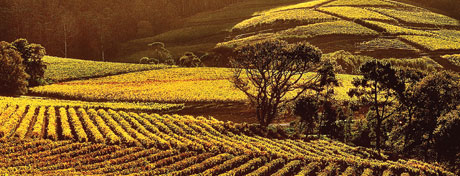
Well, we’ve started a new year, and a new decade. So, it's time for something a little different. Let’s have a show of hands -- when was the last time you had a wine from South Africa? I thought so… South African wines were generally poor quality and virtually unknown in the U.S. before the 1990s when the country was isolated from the international community because of its apartheid policy. As shown by our wine of the week, that has changed.
South Africa has been making wine for over 300 years. Europeans settled the area in the mid 1600s, and soon planted vineyards. Cape Town harbor was a provisioning stop for ships sailing around the Cape of Good Hope in the Europe - Far East trade, so the economy was booming. By the 18th and 19th centuries, the area surrounding Cape Town produced quality wines, including one of the world’s most prestigious dessert wines -- Vin de Constance.
- Vin de Constance, produced in the Constantia ward near Cape Town, was embraced by the European royalty. Louis XVI had 2,600 bottles in his cellar, and Napoleon had a bottle a day while exiled on the Island of St. Helena (an early example of a minimum security prison, no doubt.)
- Despite a promising start, the country’s wine industry hit the skids starting in the mid-1880s. Soon, a combination of vine diseases, the opening of the Suez canal, and the Anglo-Boer War destroyed South Africa’s export market. Vin de Constance was no longer produced, and the wine industry was controlled by a large, state-sponsored cooperative that excelled in mediocrity.
With the end of apartheid and the country’s economic isolation, the South African wine industry began to revive in the 1990s. South Africa currently is the world’s eighth largest producer, although much of its wine is, at best, uninteresting. But there are some excellent vineyards (they call them wine farms in South Africa) producing world class wines at reasonable prices. As is so often the case, the trick is to identify the good producers.
- Virtually all of the country's quality wine is produced in the area around Cape Town. Surprisingly, the Cape region has a cool climate, influenced by ocean currents from Antarctica. Although we'll focus on just one small region today, some of the top wine producing regions include:
- Stellenbosch, which produces some excellent Cabernet Sauvignon;
- Paarl, a slightly warmer region that produces some excellent Rhone varieties, particularly Shiraz; and
- Constantia, which, as you'll see below, can produce a great Sauvignon Blanc.
- South Africa faces some interesting challenges: in addition to frequent droughts, which made the 2015 and 2016 vintages problematic, it seems that the country's baboons love to eat grapes before they can be turned into wine!
Our wine of the week is the Klein Constantia 2018 Sauvignon Blanc ($21 retail). Klein Constantia is part of the original estate that made Vin de Constance. While it's once again producing that dessert wine, its cool-climate Sauvignon Blanc is more intriguing. This is a 100 percent Sauvignon Blanc wine, aged for seven months on its lees (dead yeast cells that can give the wine a toasty note).
- South African Sauvignon Blanc has a different character from those produced elsewhere in the world, and this wine is an example of how good it can be. It's more full bodied and subdued than a Sauvignon Blanc from New Zealand, but more fruity and engaging than that typical of France. On the nose, it has interesting notes of honeysuckle, lemongrass, citrus and stone fruit. It's well-balanced, with a steely acidity, and a long and interesting finish. After several sips, we thought the wine was a bit mysterious - every time we thought we had it figured out, another wave of flavor hit us and made us rethink it.
- We've added this to the Wine Concepts' favorites list. It's a great value for $21, and one of the most interesting wines that we've had at this price point.
Cheers!
